Some players get traded a lot. Other players never get traded. Sometimes, you can learn a little about a player just from the teams that have traded for him, but trades don’t always provide useful information. As a general rule of thumb, it’s a good thing for the Oakland Athletics and Tampa Bay Rays to fancy you as a player, and so I’m going to write about a player that both of these teams have traded for. He ended up not being all that effective for the Athletics, so they sent him to the Rays in a three-way deal to acquire Jurickson Profar. For now, he’s found his home in Tampa Bay, where he’s remade himself as a pitcher. The player I’m ever-so-cryptically talking about is Emilio Pagan.
In the past, Pagan has been a fastball-slider guy, with a changeup. Now, he’s a fastball-slider guy, with a curveball. Swapping his changeup out for his curveball hasn’t been the catalyst for what’s going on, but it clearly hasn’t hurt. During the offseason, he stopped drinking soda and limited carbs, which precipitated a loss of ten pounds. It’s unclear how causal the relationship between his weight loss and performance is—I certainly have my doubts—but it seems important to note.
Here are Pagan’s numbers, from 2017 to 2019:
| IP | K-BB% | HR/9 | ERA- | FIP- | xFIP- | |
| 2017 | 50.1 | 24.5 | 1.25 | 77 | 76 | 93 |
| 2018 | 62.0 | 16.8 | 1.89 | 104 | 119 | 112 |
| 2019 | 20.2 | 32.0 | 0.00 | 10 | 24 | 52 |
Obviously, something has changed. Granted, most of his 2019 numbers jump off of the page, but what sticks out most to me is Pagan’s HR/9. We know that home runs are noisy, but Pagan has shown the biggest decrease in flyball percentage in the league from 2018 to 2019, with a 20.7% decrease. To simplify how drastic of a change that is, Pagan went from the 99th percentile in flyballs (i.e., second-highest fly ball rate) to the 41st percentile. In terms of fly balls, he essentially went from the most extreme pitcher in the league to an average (or slightly below-average) pitcher in the league. In this case, average is good! This alone helps to contextualize his colossal decrease in home run rate, but there’s a lot more to Pagan than a simple decrease in dingers.
Here’s a list of the top six four-seam fastballs, sorted by swinging-strike percentage:
| SwStr% | Zone% | |
| Josh Hader | 25.3 | 52.6 |
| Emilio Pagan | 20.9 | 56.4 |
| Joe Jimenez | 16.8 | 61.1 |
| Gerrit Cole | 16.6 | 56.9 |
| Pedro Baez | 16.5 | 41.2 |
| Edwin Diaz | 16.2 | 55.1 |
If given a chance to guess, I’m not sure many would think that, by swinging-strike percentage, Pagan has the second-most dominant heater in the league—I sure wouldn’t have. Perhaps most impressively, Pagan gets swinging-strikes at his rate despite the fact that he throws his fastball in the zone more than anyone in this group, aside from Joe Jimenez. Put simply, Pagan’s fastball is extraordinary.
To really illustrate how far ahead of the pack he is, here’s a graphic with the same information, just in a more visually appetizing form. The top six four-seam fastballs, plotted by zone-percentage and swinging-strike percentage:

Featured Image by Justin Paradis (@freshmeatcomm on Twitter)
Here, it’s a little easier to see that Hader’s fastball is in its own league, but aside from him, Pagan’s fastball is far ahead of the rest of the pack. There are three tiers: Hader, then Pagan, then the others. It’s not shown in the table above, but by CSW, Pagan’s 31.9% ranks third on this list, just behind Jimenez’s 33.6% and Hader’s 35.3%. If it’s not clear yet, Pagan has been insane, and it all starts with his fastball.
It’s not this simplistic, but let’s compare Pagan’s and Hader’s fastballs. We’ll compare fastball velocity and spin, by percentile:
| FA velocity | FA spin | |
| 2018 Pagan | 67 | 94 |
| 2019 Pagan | 83 | 91 |
| 2019 Hader | 86 | 41 |
By velocity, Pagan and Hader’s fastballs are equals. By spin rate, Pagan blows Hader out of the water. Nonetheless, Hader bests him in swinging-strike percentage quite easily—this is despite the fact that this is a pitch that Hader throws almost 90% of the time. He gets away with this because he gets an inordinate amount of deception from his delivery, but regardless, it’s impressive enough for Pagan’s fastball to even be in the same vicinity as Hader’s.
I spoiled it in the table above, but here’s one major change Pagan has made. His fastball velocity, from 2017 to 2019:

In 2017, Pagan’s fastball averaged about 94 mph. In 2018, it averaged about 94.5 mph. This year, it jumped an additional tick to 95.7 mph. His fastball was already elite by spin rate, and now he has a fastball that’s faster than that of 83% of his peers.
To better illustrate how Pagan has changed, I’m going to break up my analysis between lefties and righties. Because Pagan is a reliever, hitters haven’t accumulated as many plate appearances against him as we’d like—especially against lefties—but it’s worth analyzing nonetheless. We have a larger sample for righties, so we’ll begin there.
Righties
Pagan has finally begun to elevate his fastball, which was an obvious change to make, given his spin rate.
His vertical pitch location against righties, from 2017 to 2019:
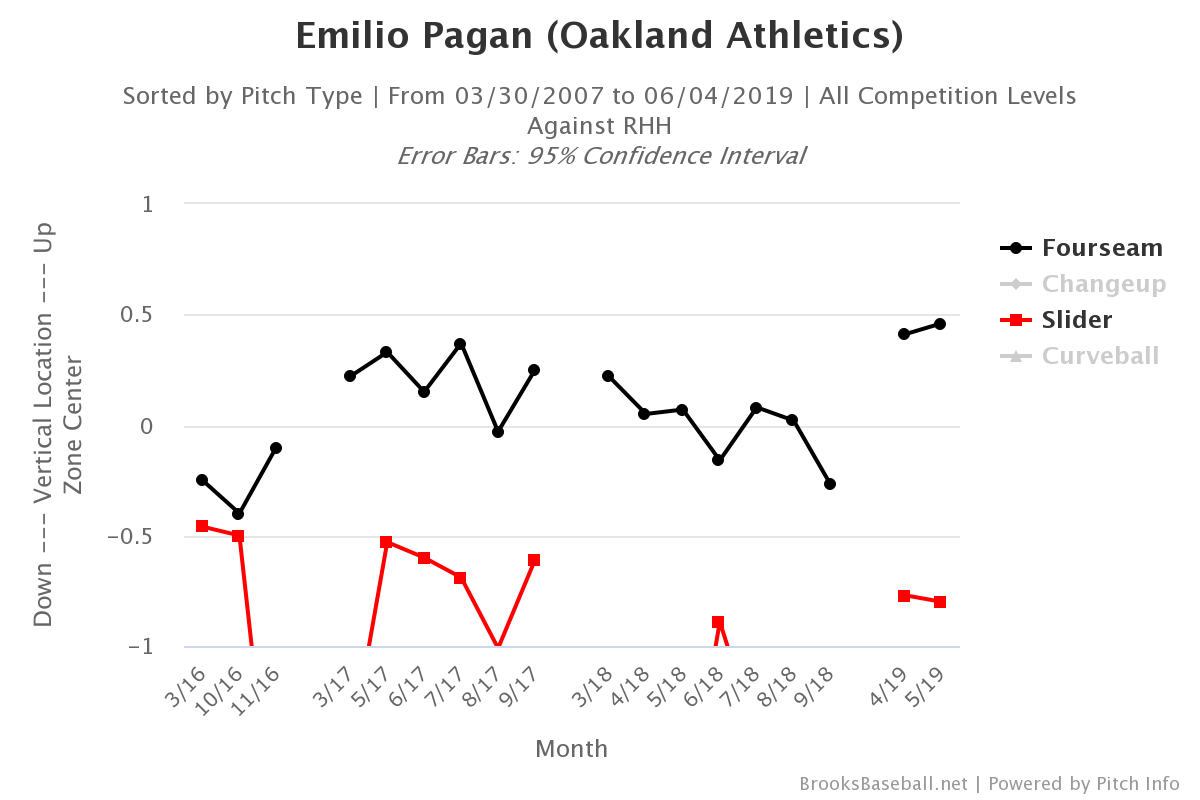
If you’ll notice, with the Mariners (in 2017), Pagan averaged a slightly elevated fastball, but in 2018, he progressively lowered it throughout the year. This year, the Rays have utilized him mostly in the same manner as the Mariners did, but this time, they’re having him elevate his fastball even higher, and his slider has risen from last year too. I’ll expand on this more in a moment, but first, I want to show all of this visually.
Here are two heat maps comparing Pagan’s fastball location against righties, in 2018 and 2019:
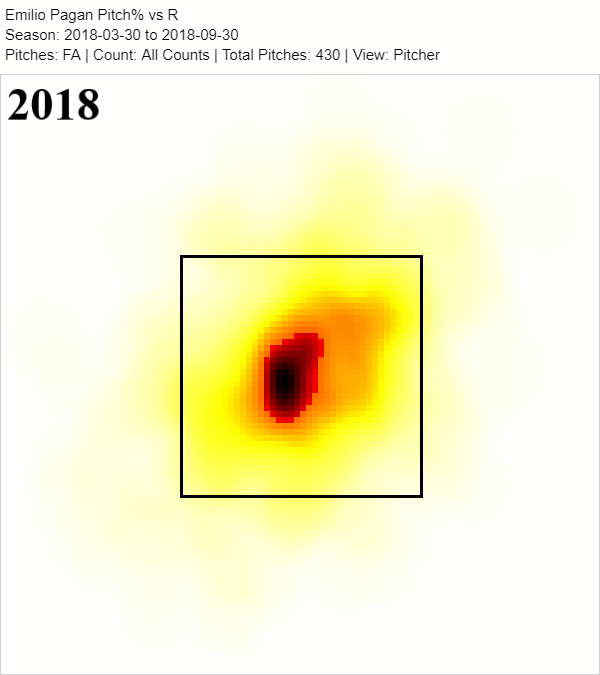
Whereas Pagan was concentrated in the middle of the zone last year, his fastball is elevated more than it has ever been—Pagan ranks eighth in the MLB in vertical fastball location against righties, averaging a fastball six inches above the center of the zone. That puts him a touch above teammate Tyler Glasnow, whose elevated fastball I wrote about recently.
This is where Pagan’s slider comes in: It’s a different pitch this year. First, he’s added 2.5 mph to it, and has consequently lost about five inches of vertical movement. It’s unclear what has precipitated these changes. It doesn’t seem we can point to a significant enough change in arm slot, and there isn’t a lot on if he’s changed his slider grip. This article says he worked on adding a 12-6 curveball, as well as a slider during the offseason. Unless it’s a typo (which it appears that it is), that insinuates that this is, indeed, a purposeful change to his slider. There is, however, a strong chance that it was a typo, as this article says the second pitch he worked on in the offseason was a changeup.
Pagan’s slider location versus righties, in 2018 and 2019:

While he’s always been a fastball-dominant pitcher, he’s begun to throw his slider more than his fastball against righties, and increased his slider’s zone percentage by almost 10%, from 43.7% to 53.2%. This is because hitters have to respect his fastball, and—compared to last year—it should theoretically tunnel better with his fastball.
Pagan’s pitch percentage against righties, from 2017 to 2019:
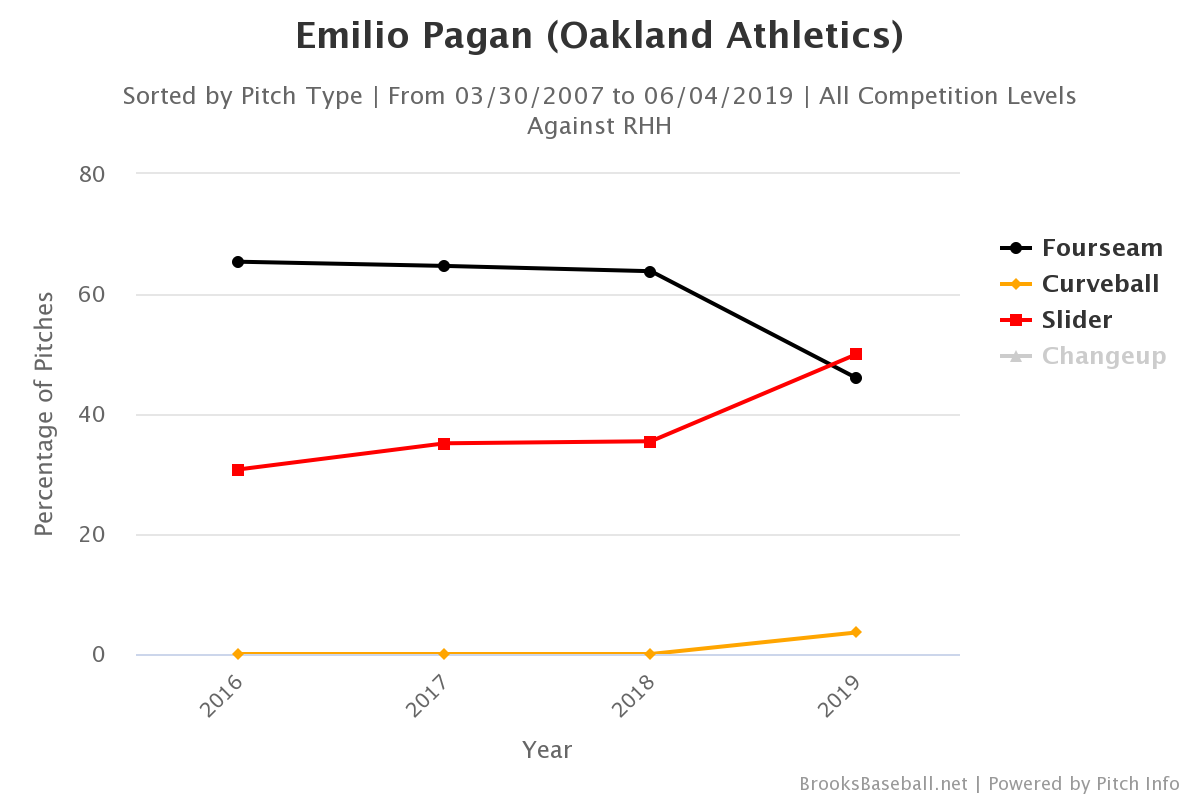
Although his slider is certainly an effective pitch, I’m not entirely convinced that his new setup is the optimal setup for him. To make it easier to digest, I’ll put it in a list:
- His overall xwOBA against righties is up from 0.169 to 0.287
- Swing and miss percentage is down by 7.9%
- Slider K% is way down
- Slider BB% is way up
By wOBA, Pagan’s fastball and slider (.160 and .157 wOBA, respectively) have been equal. By xwOBA, his slider has overperformed by .130 wOBA, while his fastball has underperformed by .052 wOBA. Because his fastball has been superior in just about every respect, I would speculate that Pagan’s slider could stand to benefit if he started throwing his fastball a touch more. For most pitchers, I would advise the opposite—but Pagan isn’t like other pitchers.
Pagan’s slider was more effective last year, despite the fact that he has a much more dominant fastball now. A few reasons for this are (a) his slower slider was actually better suited for him, or (b) he actually should be burying his slider more, rather than throwing it in the zone. I can see either argument here, as his slider’s K-BB% has dipped by about 8% this year, but I think the latter point is more supported: Pagan has seen his outside-swing percentage on his slider increase from 29.9% to 47.3%. This suggests that—if he’s comfortable throwing more balls—which, I think he can afford to do, then he should start throwing his slider lower and out of the zone.
In terms of lack of improvement, by xwOBA, against righties, I would point to his slider. In any case, he remains elite against righties, and at this point, we’re splitting hairs, because he’s remained strong against righties. Put simply, I think it’s important to show that he can improve against righties with a few subtle changes—he just doesn’t need to. With that said, we’ll move on to his new approach against lefties.
Lefties
This offseason, Pagan made it a point to try and improve against lefties to make himself a more versatile reliever. To do this, he added a 12-6 curveball. Although xwOBA doesn’t help us much in the way of predictiveness, it does appear to do a good job explaining how fortunate (or unfortunate) a player has been. By xwOBA, we can deduce that Pagan has accomplished his goal of improving against lefties.
Here’s a chart, showing Pagan’s xwOBA versus lefties and righties from 2017 to 2019:
| vLH | vRH | |
| 2017 | .302 | .218 |
| 2018 | .427 | .214 |
| 2019 | .225 | .218 |
Pagan was incredible against righties, and he’s remained incredible against righties. Although these numbers don’t demonstrate the gains Pagan has made in swing-and-miss ability against righties, what’s truly been remarkable is his improvement against lefties thus far—at this time, his platoon split is negligible, whereas last year, his xwOBA against lefties was almost exactly two times his xwOBA against righties.
Although he’s just added a 12-6 curveball, Pagan is currently only using it to show hitters another pitch. Since he’s barely using his curve, I think his growth against lefties has much more to do with his improved pitches and location. He has completely rid his repertoire of his changeup and sinker and has compensated by throwing his curveball about 8% of the time and, more importantly, upping his slider usage.
First, Pagan’s fastball location against lefties, in 2018 and 2019:
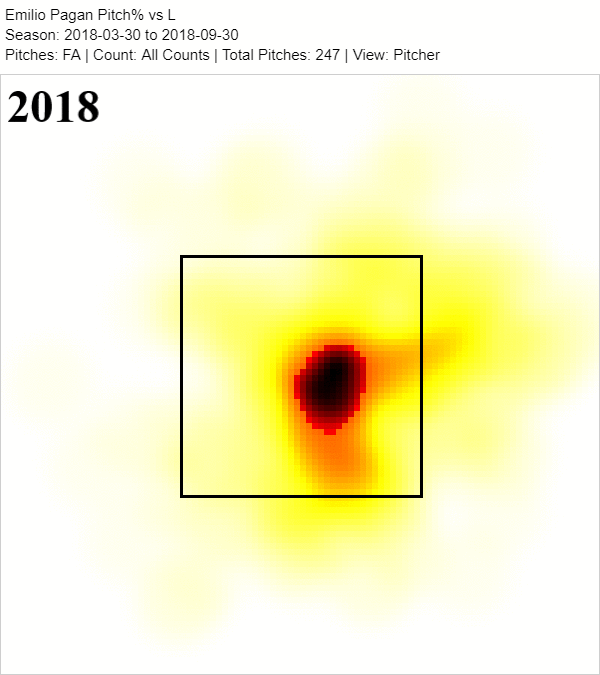
Importantly, he’s elevating his fastball more overall, but he’s also doing a nice job of keeping it away from hitters and on the edge of the plate. This sets up his slider.
Pagan’s slider location versus lefties, in 2018 and 2019:
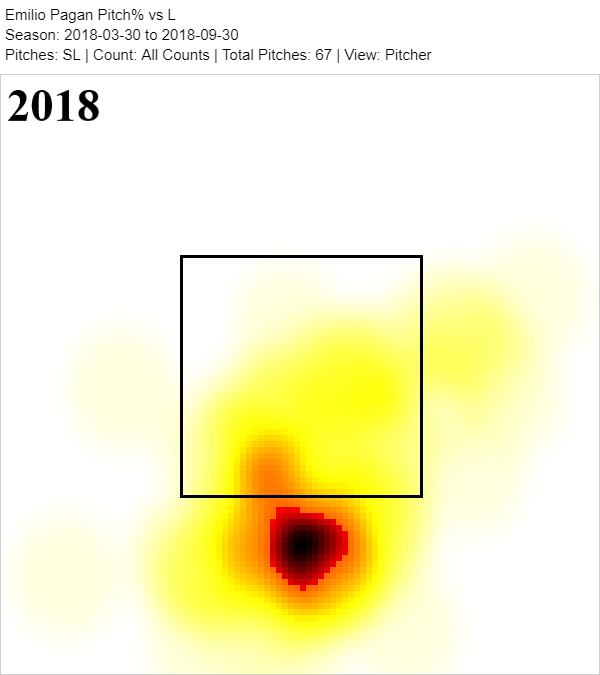
Pagan’s slider has crept up in the zone more. It’s not all that easy to tell by looking at his heat maps, but his slider zone-percentage against lefties has increased by 7.2%, which is a considerable improvement. Again, because hitters have to respect his fastball, Pagan has been able to place his slider in the zone more, with great effectiveness. It would be interesting to see Pagan attack the back foot of lefties more often, but I’m not going to question his current combination of results and peripherals.
Conclusion
The Rays have been doing this for a while now. Elevated, high-spin fastballs, paired with low breaking balls. It’s no wonder they went out and targeted Pagan. According to the man himself, he’s still a work in progress. He’s still looking to become more than a two-pitch pitcher, because that’s mostly what he is right now. His curveball clearly needs more work, since it’s not a pitch he can throw with adequate volume or command.
Regardless, it’s hard to argue with these results. Pagan is in the 98th percentile in K%, and he’s in the 99th percentile in xwOBA. I find it hard to believe that he won’t allow a home run all year—and the BABIP and left-on-base percentage don’t seem entirely sustainable—but it’s impressive nonetheless that he has yet to do so in 20.2 innings. In Emilio Pagan, the Rays turned a good reliever into an elite reliever. At least so far.
Featured Image by Justin Paradis (@freshmeatcomm on Twitter)


And
I
was
like
EMILIOOOOOOOOO!
I need a 3rd closer in my 12-team Saves (no Holds) league. I’m currently hanging onto Leclerc in the hopes he regains the Closer role in Tex. I know Tampa has been a revolving door for closers. Who would you recommend as the RP most likely to take over as closer this year – Pagan or LeClerc?
Leclerc has been ON FIRE for about a month now. I’d hold onto him for sure, especially since he has a more prominent closer role, and their bullpen isn’t as deep as TB’s.
Love watching Emilio altho his role has been frustrating for me consistently keeping him in my (S/H points) league
Totally agree. I think he’ll get more opportunities going forward, but for the time being, it *is* really frustrating. Patience!